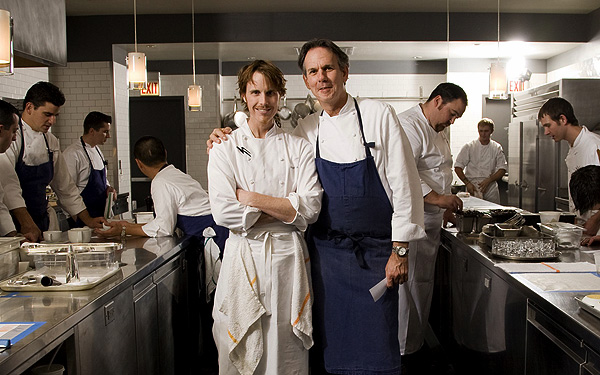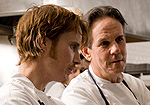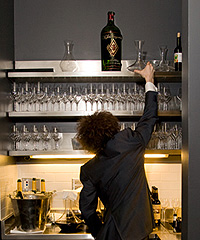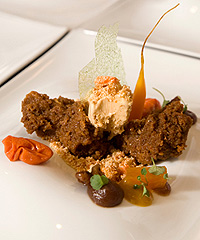
Achatz and Keller. See more photos in the gallery >>
When I found out Thomas Keller was coming to town to cook side-by-side with Grant Achatz, his most famous and successful protégé, I thought to myself: Must. Be. There. The two chefs had teamed up to do a series of events—one at Per Se in New York, one at Alinea, and a final stop at The French Laundry in California—each a three-hour, 20-course meal priced at $1,500 a head. I’m not even sure why I found the idea of this event so thrilling. Was it the outrageous price tag as we teeter on the brink of a depression? Was it the presence of Keller, perhaps America’s most renowned chef, here in Chicago? Was it the poignancy of Achatz, who recently went through a harrowing battle with cancer, reconnecting with his old mentor? Was it the submerged psychology of the whole affair? After all, Achatz came of age as a cook at Keller’s knee, rising from a 22-year-old line cook to sous chef at The French Laundry, his mentor’s reputation-making restaurant in Yountville. “Talk about the anxiety of influence,” said Michael Ruhlman to the New York Times about the dynamics surrounding the dinner at Per Se that happened three weeks before. “The need to slay the father.”
|
|
Two nights ago, on December 2nd, about 50 diners arrived at Alinea (1723 N. Halsted St.; 312-867-0110). The house would be full, with staggered seatings from 6:30 to 7:30 p.m. At a late afternoon meeting for the wait staff, Achatz told a fun story about one of the wines being served that evening—the 1997 La Jota 16th Anniversary, a cabernet sauvignon from Napa Valley. In 1999, Achatz took a year off from his job at The French Laundry to work at a winery in Napa Valley. One of his tasks that year included hand-bottling some of the wines. “Literally, I pumped the wine into the bottle with a hose and slugged a cork in it,” he said, referring to the magnum sitting on a shelf in Alinea’s second floor staging area. “I’ll be really curious to see how it turned out.”
Over the course of the evening, I watched the two teams—Alinea on the right in white, French Laundry on the left in blue aprons—unleash a river of food, taking turns with the courses. Keller and Achatz mostly supervised the assembly lines and occasionally dipped in to help. I asked Keller if he saw a family resemblance on the plate. “I don’t know if I’d call it a family resemblance,” he said. “It’s more a philosophical continuity: Our desire to have an experience in the kitchen that is equal to the experience in the dining room.” He explained that “back in the day,” when he was coming up in the business, restaurateurs—not chefs— controlled the conditions in the kitchen, which typically resulted in soulless production dungeons. Within a couple of years of Keller’s opening of The French Laundry, his first restaurant in a two-story stone building in California wine country, Keller says he had the notion to extend the serenity of the dining room inward. “When a kitchen is organized, efficient, calm, and collected, there’s no frustration, anxiety, or stress,” he said. “It’s really about us as well.” Keller, gesturing at the carpets on the floor in the Alinea kitchen, went on, “This kitchen is magnificent. There’s carpet on the floor! If it’s a rubber mat, who cares what you throw down there. It breeds a certain sense of pride in what you’re doing.”
|
|
Keller wouldn’t take credit for instilling this philosophy in Achatz, so Achatz did it for him. “Oh, totally,” Achatz said, when I asked if he had adopted this philosophy as his own. He also saw many similarities between his and Keller’s food. “Having his dishes next to mine is very grounding,” Achatz said. “His starting points are exactly the same. But we have more components, more technique, more flavors, and more textures.” As he said this, we looked at “Spice Cake,” a dessert course that was being assembled at the station next to where we were standing. To me, the garnishes on the rim of the bowl looked like, well, chewed-up gum. Achatz insisted that the flavor combination—carrot, persimmon, rum—was as classic as anything Keller was putting together across the room, just extrapolated and extended.
And how was that 1997 La Jota? A couple days later, he replied via e-mail: “When I stuck my nose in the glass it immediately transported me back to Howell Mountain in 1999. I could see it, smell it, and taste it. It conjured memories of Bill Smith showing me how to plant, prune, and train the vines. The way the heavy fog hung through the valleys. The awesome campfire meals cooked by the staff of 4 Mexican vineyard workers—“not too hot for the young red one,” they would say in Spanish. Bill handing me a pair of wine stained shorts and pointing to the fermenter, saying “Get in!” And the haunting feeling of how much I missed cooking and how I had to leave this magical place and its people in order to return to what I love to do. That’s what it tasted like.”
Photography: Courtesy of Lara Kastner






